Special Reports
The Pacific Northwest Ballet Gets Past “It’s Not for People like Us”
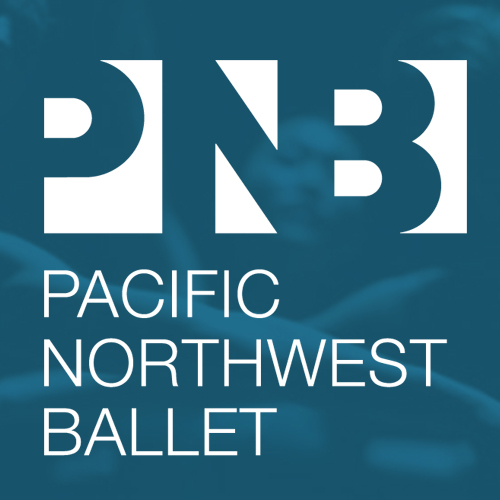
Pacific Northwest Ballet is the fifth-largest ballet company in the United States (annual budget, $23 million), and presents a diverse repertoire of classical and contemporary ballet in over 100 performances
each year. It also includes a school with a professional-track curriculum, as well as non-professional classes for children and adults.
The Challenege: Ballet is perceived as old fashioned and elitist

When Peter Boal became artistic director of Seattle’s Pacific Northwest Ballet (PNB) in 2005, he prioritized building teen and young adult audiences, responding to nationwide trends of sharp declines in attendance at performing arts events. (National Endowment for the Arts surveys reflect an estimated 10 percent decline, at least, since the 1990s.) He believed it was essential to “plant the seeds” for audiences of the future, or ballet could all but disappear. The challenge was one of relevance: young people thought that ballet was for their parents and grandparents, not for them. “There are certain performing arts that young audiences do care about,” says Boal. “They care about hearing a musical group. They care about certain films. I want ballet to be in that category.” [PHOTO: Pacific Northwest Ballet Artistic Director Peter Boal.]
The Goal: Change perceptions; reach a younger and broader audience
Strategy I: Lower ticket prices
An important first step was creating several low-price attendance opportunities, which not only provided access but also signaled that ballet was for everyone, not just those of a certain economic standing. These programs included
- $5 one-hour rehearsal previews on select Fridays every two to three months hosted by Boal and his artistic staff in PNB’s rehearsal studios. These regularly sell out (there are only 200 seats) to audiences young and old.
- A “25 & Under” program allowing patrons ages 25 and under to buy two tickets for $25 (or one ticket for $15) for any Friday performance. Six months after this program launched, PNB was regularly selling more than 250 tickets per performance.
- Partnering with TeenTix, an arts access program that offers teenagers $5 day-of-show tickets for nearly 60 organizations throughout Seattle. Just shy of 1,000 teens bought tickets to PNB performances in the first years that program ran.
Strategy II:
Crack the relevance barrier

Boal and Ellen Walker, then marketing (now executive) director were pleased by the modest response to the ticketing programs, but they were not seeing a growing momentum. They felt they needed to still break through that relevance barrier. Walker believed the company would need to communicate to teens and young adults in a different way. She had heard from younger audience members that PNB’s online presence was lacking—the web site was difficult to navigate, and PNB was not active in social media spaces. [Pacific Northwest Ballet Executive Director Ellen Walker.]
To support new online and offline communication and outreach strategies, PNB applied for and received a four-year (2009–12) $750,000 Wallace Excellence Award from The Wallace Foundation. The award
- supported a web site redesign
- funded an expansion of PNB’s in-house video production capabilities
- allowed PNB to update its visual brand identit
- underwrote a research program that helped PNB gain a better understanding of how to connect with teens and young adults
- Specific goals included increasing ticket purchases by 40 percent and increasing repeat visits—the number of young adults who return for two or more events within the same season—by 20 percent.
Step 1. Conduct market research
As a first step, PNB engaged third-party research partners to conduct two rounds of focus groups with teens and young adults exploring their perceptions of ballet, the company, its web site, and its marketing. The focus groups revealed that ballet had the kinds of barriers facing many classical art forms, including perceptions that it was elitist and stuffy. They also pointed out some ways that PNB’s communications (inadvertently) reinforced those perceptions (discussed further below). Addressing these barriers meant changes to the web site and promotional materials to communicate approachability and accessibility while still conveying the artistic excellence the company’s current audience cherished. Walker saw this as critical—teens and young adults needed to hear again and again that they were welcome at PNB. She says: “We wanted to create convenience, to create dialogue, and to create a sense of belonging for everyone…. We wanted to say, ‘We’re all these things under the umbrella and there’s a place for you here.’”
Step 2. Act on market research
Focus-group sessions indicated that both the web site and advertising materials inadvertently reinforced notions of ballet as boring, stuffy, and of PNB as aloof. The web site communicated staid formality. Young people who knew PNB said the somber color scheme did not reflect the excitement of attending a performance. Those unfamiliar with the company said they could not find enough information to get to know PNB from the outside. Walker had heard anecdotally from students and younger visitors that it was clunky and difficult to navigate.
A) Redesign web site
A professional web design firm was engaged to update the web site with a new and more inviting color scheme, less clutter, and more intuitive navigation. The redesigned web site also had greater content and functionality, including:
- Expanded ticket-buying capabilities, with seat selection and online subscription purchase
- Video and image galleries for each performance and for specific fundraising campaigns
- An online calendar that provided a monthly view of upcoming performances and events, with each entry linked to its own web page providing detailed event information
- A link to the real-time traffic report for the area around the theater to help attendees plan how to get to performances
- Additional written content about PNB dancers and choreographers
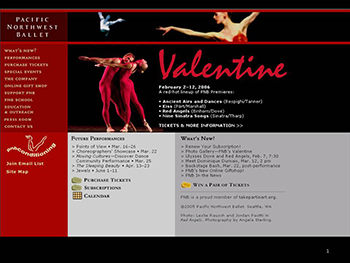
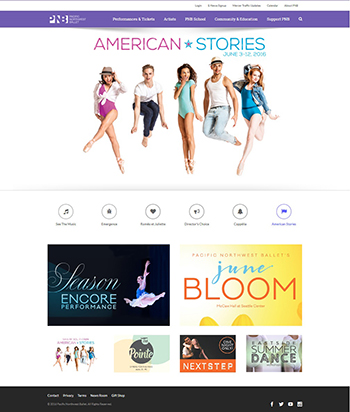
B) Expand in-house production capabilities
PNB wanted to expand its in-house production capabilities to create a steady stream of videos to post on YouTube and platforms like Twitter and Facebook. The idea was to introduce new audiences to the dancers and their everyday, behind-the-scenes goings-on in classes and rehearsals, as well as to promote upcoming programming. An intern with an HD camera, a Mac computer, and editing software (total cost, less than $7,500) created the videos, which soon won thousands of YouTube fans and millions of annual views. It was a low-cost way to create interaction and dialogue around ballet.
Overhauling the web site with the new videos, easier navigation, greater functionality, and a more aesthetically pleasing design took over a year; it was done with continuous input and review by PNB staff. Research with visitors to the web site indicated it was working. [PHOTOS: Screenshots, PNB homepage before and after web site redesign.]
C) Update visual brand identity
As the focus groups indicated, PNB’s advertising images were alienating to young people. Images of tiaras and tutus made them think ballet would be expensive. Distant stage shots made it difficult to see the emotions on the dancers’ faces. Close-up photos of dancers holding positions that showcased precision and technical prowess looked awkward to people unfamiliar with ballet. Nothing communicated excitement.
So PNB changed its promotional look, moving to a lighter color palette, updating fonts (which focus group participants called “boring”) and logos. Images of dancers holding awkward poses were dropped in favor of close-ups of company members showing intense emotional expressions or gazing directly at the viewer, with the goal of conveying immediacy and excitement. [PHOTOS: Advertisement before and after focus-group research.]
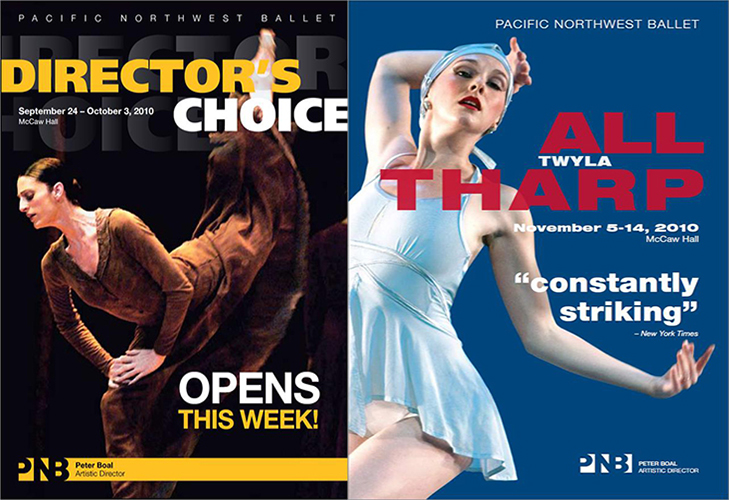
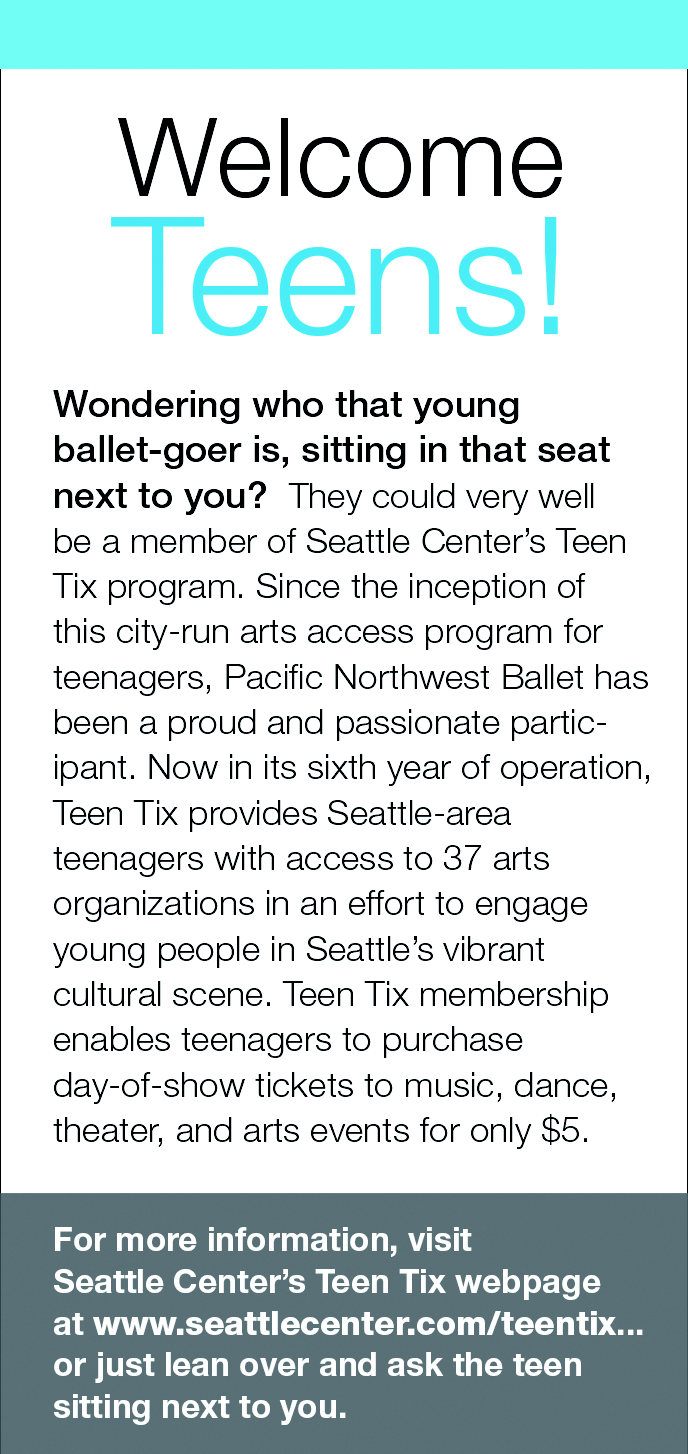
D) Create exclusive programs
In response to concerns among some teens that they might feel uncomfortable as the only teens in an audience of older adults, PNB created a teen-only preview of “Next Step,” its annual showcase of new work by PNB choreographers. This gave young audiences a sense of exclusivity, as well as putting them together with peers and performers, many of whom were to close their own age.
E) Foster welcoming atmosphere
The company also made sure to welcome teens and young adults at its performances. Says Boal, “We talk to our ushers, our house manager, and all of our staff about being there to greet them and make them feel that they are important patrons of the ballet. Even if they only spent $5 or $12.50 to get in, we value the fact that they’re there.” Boal would introduce himself to young adults who were sitting in a special section of the house, and an announcement was placed in every program welcoming teens and, importantly, explaining to the rest of the audience why their presence was essential to the company’s future.
Results

Over four years, PNB’s ticket sales to teens more than doubled and ticket sales to young adults under age 25 rose by 20 percent. Moreover, the number of teens and young adults who attended more than one performance per season rose by 55%. PNB effectively bucked national trends. The case study report highlights several factors contributing to PNB’s success, including an integrated strategy for welcoming young audiences and helping them get to know the company, as well as the remarkable alignment of the artistic and marketing teams.
Costs
This campaign was not cheap. By far, the greatest costs were research and the web site redesign.
- Web site: Professional fees to cover the scope, design, production, alignment with Tessitura, new code, and upgraded functionality totaled approximately $270,000.
- Research: The two rounds of focus groups carried a budget of $80,000, and web site visitor surveys before the redesign and at two follow-up waves, cost approximately $50,000.
- New Look and Feel for PNB brand. The consultant fees for developing a new color scheme and PNB visual brand identity were approximately $40,000. Certain components of PNB’s initiative delivered great value at a low cost, including the videos, teen preview night, and PNB’s partnership with TeenTix.
This case-study summary is based on The Wallace Foundation’s Getting Past “It’s Not For People Like Us”: Pacific Northwest Ballet Builds a Following with Teens and Young Adults.
 Bob Harlow, PhD, is a veteran market researcher who has spent 20 years using surveys, focus groups, and advanced analytics to help organizations more deeply understand their target audiences. He currently leads Bob Harlow Research and Consulting, LLC, a market research consulting organization.
Bob Harlow, PhD, is a veteran market researcher who has spent 20 years using surveys, focus groups, and advanced analytics to help organizations more deeply understand their target audiences. He currently leads Bob Harlow Research and Consulting, LLC, a market research consulting organization.





 FEATURED JOBS
FEATURED JOBS

 RENT A PHOTO
RENT A PHOTO


